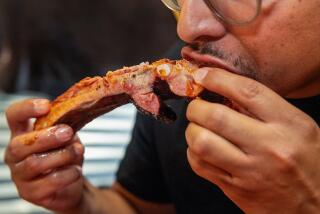Firm Hopes Pigxies Hog Market, Bring Bacon : Risking boardom, this mail order entrepigneur believes his swine are more equal than the other guy’s creatures.
SAN CLEMENTE — With Ninja Turtles, trolls and a purple dinosaur up against you, making even a dent in the creature business takes market savvy, fiscal know-how and an unending appetite for puns.
Craig Stern’s swine-themed mail order products business, Pigxies Inc. in San Clemente, has tapped into the market with Pigcasso paintings, Mudonna T-shirts and Old Pigdonald overalls. Pictures of hogs sailing off the coast are aptly dubbed The Bay of Pigs.
Compared to other creature manias, he’s only scratched the surface, Stern said. But what was just a few years ago was a garage-run wholesale T-shirt business has grown into a full catalogue of products, including watches, lamps, silk jackets and even butter trays. Stern fills about 30 orders a day, all with the hope that this is the beginning of a national craze.
“Our ultimate goal is to do a cartoon show or a book, to be like Peanuts,” said Stern, 45.
Last year, sales reached about $350,000, quadruple what it took in six years ago, when Stern bought a majority stake in the operation. About three-fourths of the sales are by mail order, culled from a 90,000-name list.
But why, of all things, are they latching on to the pig theme? (Or, as Stern is quick to correct, Pigxies, which walk on two feet.)
“There’s just a lot of people who like pigs,” he said. “They are just lovable little guys.”
It all started back in 1984, when Pigxies creator Detlev Rothe, a clothes designer and owner of Tops, a Laguna Beach apparel store, created a T-shirt depicting athletic hogs that were dubbed “Olympigs.” Rothe set up a booth across from the Los Angeles Memorial Coliseum for the 1984 Olympics, and his shirts sold quickly.
It was enough to draw the interest of department stores and boutiques, who sold his products for about two years. Stern, a former real estate developer and longtime friend of Rothe’s, bought a majority stake in the business in 1986.
Until 1990, when the first catalogue debuted, Stern’s business depended on fairs and swap meets to sell the Pigxies products. While he still travels to about 10 shows and fairs a year, the big sales are by mail order, which average about $45 to $50 each.
Meanwhile, the company has little overhead, except for a small warehouse in a San Clemente industrial park. Almost all the work is farmed out to about 30 independent contractors, who do everything from embroider pigs onto sweat shirts to enter names on the mailing list.
Among the most popular items now are sweat shirts and T-shirts. Watches, including a “Don’t Pig Out” model that features a pie slice as its second hand, also has been popular, Stern said.
While the goal is to ride a national fad, Stern has learned to target the market first. Pigxies charges $1 to $2 for each publication. The theory is that people who pay for their catalogues show greater interest and are more likely to make an order.
“We draw our own market,” he said. “We bought a mailing list once and it bombed. We just can’t do it. We’re real focused.”
Another key to getting repeat customers is creating new lines of characters, often targeted to specific audiences, Stern said. The company recently added a “Head Hog” line, depicting a Pigxies character as king or queen, and an Officer Pigxie line, featuring a hog-faced cop. Police, believe it or not, are ordering too.
“It’s hysterical,” Stern said. “Police officers love them. They say that pig stands for pride integrity and guts.”
Pigxies plans to start a beachwear line next, to be called Tropigs, geared to warm-weather markets including Hawaii. The company also plans to explore the pot-bellied pig craze by marketing pot-bellied pig visors to owners’ clubs.
“They can change the themes to what the consumers like,” said Sylvia Feldman, an accountant for Stitcheree Plus in San Juan Capistrano, which does the embroidery for Pigxies. “Plus it’s something unique. You don’t see 400 people wearing what they sell.”
But that’s only the business half of the story. Rothe, who remains with the company as its chief designer, now is writing a children’s book to tell the Pigxies fable. The story would be akin to legends of gnomes, trolls and elves, and also would incorporate present-day themes, such as environmental awareness and violence.
“It gives you a glimpse of these issues in a lighthearted way,” Rothe said.
He also continues his search for more public figures to mimic. After all, he already has done so many Pigcasso paintings that he can separate the work into Pigcasso’s blue and pink periods.
More to Read
Inside the business of entertainment
The Wide Shot brings you news, analysis and insights on everything from streaming wars to production — and what it all means for the future.
You may occasionally receive promotional content from the Los Angeles Times.










